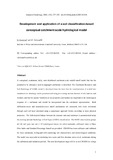JavaScript is disabled for your browser. Some features of this site may not work without it.
| dc.contributor.author | Marechal, David | - |
| dc.contributor.author | Holman, Ian P. | - |
| dc.date.accessioned | 2012-05-31T23:07:46Z | |
| dc.date.available | 2012-05-31T23:07:46Z | |
| dc.date.issued | 2005-10-01T00:00:00Z | - |
| dc.identifier.citation | D. Marechal and I.P. Holman, Development and application of a soil classification-based conceptual catchment-scale hydrological model, Journal of Hydrology, Vol 312, Iss 1-4, 10 Oct 2005, Pages 277-293 | - |
| dc.identifier.issn | 0022-1694 | - |
| dc.identifier.uri | http://dx.doi.org/10.1016/j.jhydrol.2005.02.018 | - |
| dc.identifier.uri | http://dspace.lib.cranfield.ac.uk/handle/1826/1928 | |
| dc.description.abstract | A conceptual, continuous, daily, semi distributed catchment-scale rainfall- runoff model that has the potential to be ultimately used in ungauged catchments is described. The Catchment Resources and Soil Hydrology (CRASH) model is developed from the basis that the transformation of rainfall into simulated river discharge can be parameterised using pre-existing national datasets of soil, land use and weather; and that the spatial variability in soil properties and land use are important to the hydrological response of a catchment and should be incorporated into the catchment representation. Both infiltration- excess and saturation-excess runoff mechanisms are simulated, with water movement through each soil layer simulated using a capacitance approach limited according to layer physical properties. The hydrological linkage between the response unit and catchment is parameterised using the existing national Hydrology of Soil Types (HOST) classification. The HOST classification groups all UK soil types into one of 29 hydrological classes for which nationally calibrated values of Base Flow Index and Standard Percentage Runoff are provided. CRASH has been calibrated and validated for three catchments in England with contrasting soil characteristics and meteorological conditions. The model was successful at simulating time series and flow duration curves in all catchments during the calibration and validation periods. The next development stage will be to test CRASH for a large number of catchments covering a wider range of soils, land uses and meteorological conditions, in order to derive a set of regionalised model parameters based upon the HOST classification. The successful cross-scale linkage between water movement through the response unit and the catchment-scale hydrological response using the HOST classification, which incorporates the scale effects between plot and catchment, suggests that such national soil hydrological classifications may provide a sound and consistent framework for hydrological modelling in both gauged and ungauged catchments which should be extended to other regions. | en_UK |
| dc.language.iso | en_UK | - |
| dc.publisher | Elsevier Science B.V., Amsterdam. | en_UK |
| dc.subject | Rainfall-runoff model | en_UK |
| dc.subject | Conceptual model | en_UK |
| dc.subject | Classification | en_UK |
| dc.subject | Ungauged catchment | en_UK |
| dc.subject | Semi-distributed model | en_UK |
| dc.subject | Soil hydrology | en_UK |
| dc.title | Development and application of a soil classification-based conceptual catchment- scale hydrological model | en_UK |
| dc.type | Article | - |
